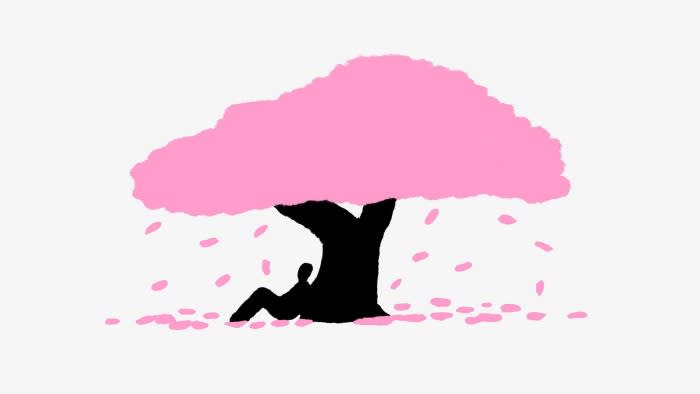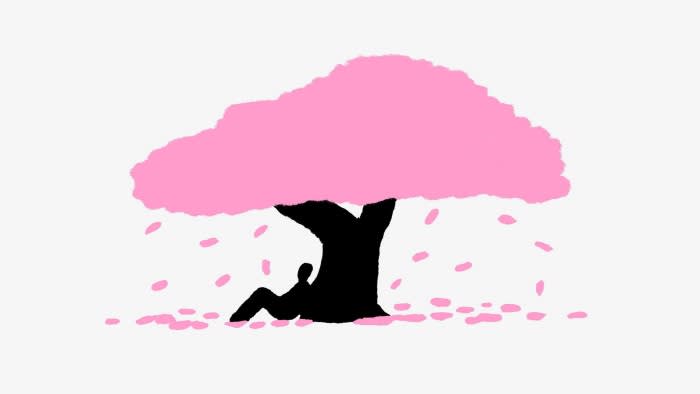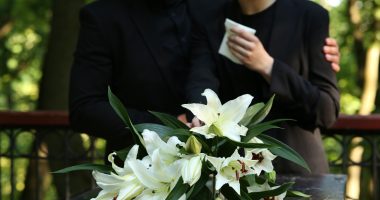
Unlock the Editor’s Digest for free
Roula Khalaf, Editor of the FT, selects her favourite stories in this weekly newsletter.
Earlier this week, on the kind of grey and dreary evening that gives London a bad name, I sat down under a cherry tree. I took out a ballpoint pen and a pad of paper, and began to sketch the thin, sinuous branches blowing above me in the bluster, and the clouds of pale pink petals punctuating them. Having sat down feeling low, I got up feeling soothed and calm.
I grew up in this city, and have always loved its frothy, dreamlike cherry blossom. But it took my travelling to Japan last year during the exuberant height of the sakura season — with its blossom-watching hanami parties and its bright pink paper lanterns lighting up the trees at night — for me to really notice the profusion of cherry bloom here in London. And not just notice it, but really do as many in Japan do and savour it.
The temptation to riff off the rich symbolism of the sakura seemed too great for the Japanese premier Fumio Kishida to resist on Wednesday, when he announced on a state visit to Washington, DC, that Japan was donating 250 more of its famous somei-yoshino cherry trees to the US capital (after an initial donation in 1912). And yet the symbolism seemed a little off. “I am confident that the cherry-blossom-like bond of the Japan-US alliance will continue to grow even thicker and stronger here, in the Indo-Pacific, and in all corners of the world,” Kishida said on the White House’s South Lawn.
His speechwriters might have given their similes a little more thought: a cherry-blossom-like bond hardly evokes an image of strength and sturdiness; rather one of fragility, delicateness, impermanence.
But outside the context of cherry blossom geopolitics, it is this very thing — the ephemeral nature of the sakura, and the way it mirrors the ephemerality of our existence — that can teach the rest of us a lesson in what we should be directing our attention towards.
One of the funny paradoxes of modern life is the way that many people appear to do something akin to savouring by recording every joyful moment (did you really see that sunset if you didn’t post it on social media?), and yet simultaneously seem unable to put down their phones and just be.
Forget happening upon the cherry blossoms; what you really want is a listicle of the most “Instagrammable” cherry blossom spots in London. Even in Tokyo it is virtually impossible to marvel at a tree in a popular viewing spot such as Ueno Park without simultaneously having to marvel at the crowds of young people taking selfies in front of it.
Yet there is a difference between “capturing” a moment and savouring it. The former is an attempt to make permanent something inherently fleeting; the latter involves paying attention to a particularly gratifying or pleasurable feeling — luxuriating in it, but then letting it go.
“You’re tasting an experience and swishing it around in your mind and in your heart as you would swish around in your mouth a fine wine or a piece of chocolate that is delightful,” is how Fred Bryant, professor of social psychology at the Loyola University in Chicago, describes the idea of savouring to me.
He has been studying the concept for four decades, having initially been inspired by a Buddhist friend who quoted an old Zen saying to him: “No moment comes twice. Each moment savoured is more precious than a span of jade.”
Bryant says learning to savour life’s joys and raptures is just as important a skill as knowing how to cope with the negative when it comes to emotional wellbeing, and even physical wellbeing: research suggests that being able to savour experiences lessens the symptoms of patients suffering from cancer. But while life’s challenges force us to learn the latter, Bryant tells me, savouring is something that we often have to make the choice to learn.
This isn’t just about bringing attention to pleasurable or happy moments and ignoring or avoiding the difficult ones, though. There is a kind of beauty and intensity to melancholy and heartache that can be savoured in a way that can bring richness even if it does not bring unbridled joy. Indeed, a central part of the symbolism of the sakura is the way it symbolises the cycle of life and death: budding, blooming, and then the final fall.
Many of us seem to have become uncomfortable with death and the impermanent. We try to freeze time by “capturing” moments on our phones, injecting our faces with Botox and filler, or taking 100 pills a day in the hope of “reverse-ageing” and living forever.
In so doing, we might forget to notice that we are living. I love this haiku from the 18th-century Japanese poet Kobayashi Issa: “What a strange thing! / to be alive / beneath cherry blossoms.”
Read More: World News | Entertainment News | Celeb News
FT










